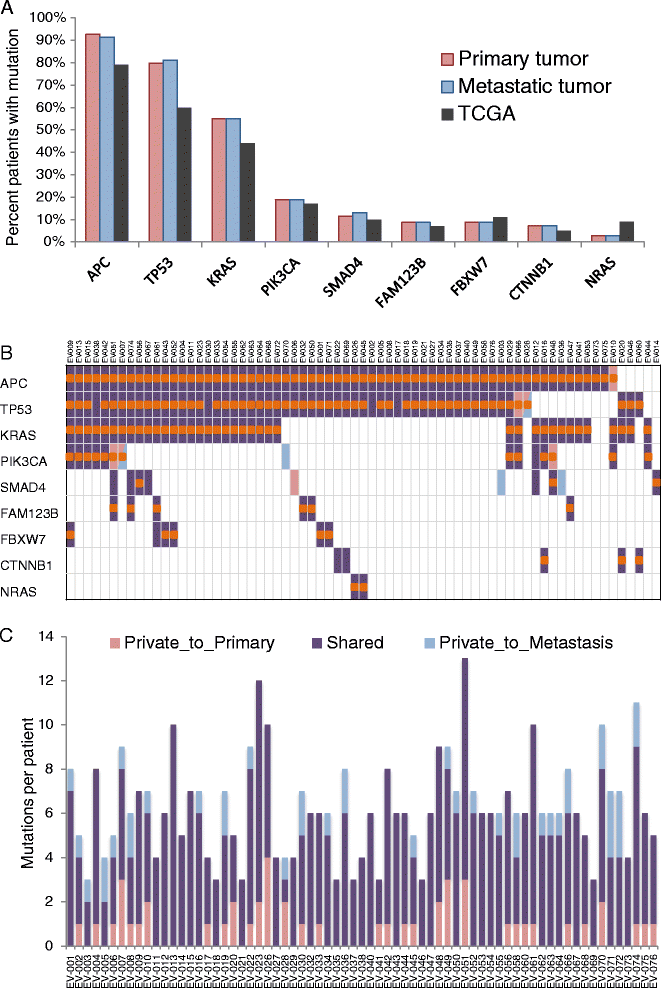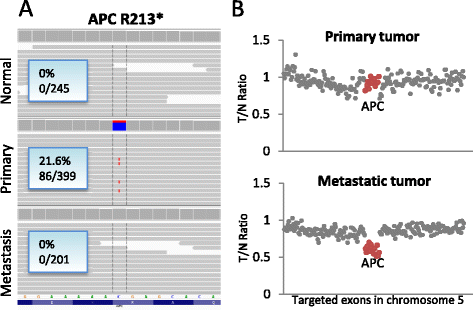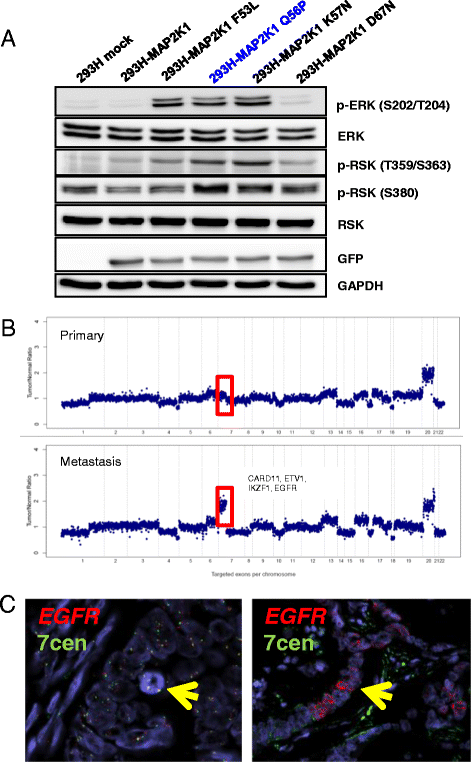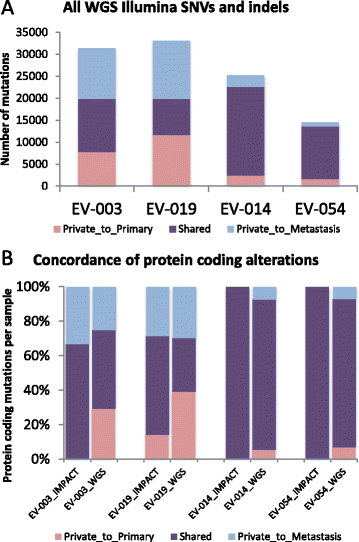Comparative sequencing analysis reveals high genomic concordance between matched primary and metastatic colorectal cancer lesions
- PMID: 25164765
- PMCID: PMC4189196
- DOI: 10.1186/s13059-014-0454-7
Comparative sequencing analysis reveals high genomic concordance between matched primary and metastatic colorectal cancer lesions
Abstract
Background: Colorectal cancer is the second leading cause of cancer death in the United States, with over 50,000 deaths estimated in 2014. Molecular profiling for somatic mutations that predict absence of response to anti-EGFR therapy has become standard practice in the treatment of metastatic colorectal cancer; however, the quantity and type of tissue available for testing is frequently limited. Further, the degree to which the primary tumor is a faithful representation of metastatic disease has been questioned. As next-generation sequencing technology becomes more widely available for clinical use and additional molecularly targeted agents are considered as treatment options in colorectal cancer, it is important to characterize the extent of tumor heterogeneity between primary and metastatic tumors.
Results: We performed deep coverage, targeted next-generation sequencing of 230 key cancer-associated genes for 69 matched primary and metastatic tumors and normal tissue. Mutation profiles were 100% concordant for KRAS, NRAS, and BRAF, and were highly concordant for recurrent alterations in colorectal cancer. Additionally, whole genome sequencing of four patient trios did not reveal any additional site-specific targetable alterations.
Conclusions: Colorectal cancer primary tumors and metastases exhibit high genomic concordance. As current clinical practices in colorectal cancer revolve around KRAS, NRAS, and BRAF mutation status, diagnostic sequencing of either primary or metastatic tissue as available is acceptable for most patients. Additionally, consistency between targeted sequencing and whole genome sequencing results suggests that targeted sequencing may be a suitable strategy for clinical diagnostic applications.
Figures




Similar articles
-
Comparison of neuroendocrine differentiation and KRAS/NRAS/BRAF/PIK3CA/TP53 mutation status in primary and metastatic colorectal cancer.Int J Clin Exp Pathol. 2014 Aug 15;7(9):5927-39. eCollection 2014. Int J Clin Exp Pathol. 2014. PMID: 25337237 Free PMC article.
-
Accurate detection of KRAS, NRAS and BRAF mutations in metastatic colorectal cancers by bridged nucleic acid-clamp real-time PCR.BMC Med Genomics. 2019 Nov 11;12(1):162. doi: 10.1186/s12920-019-0610-8. BMC Med Genomics. 2019. PMID: 31711486 Free PMC article.
-
The predictive value of KRAS, NRAS, BRAF, PIK3CA and PTEN for anti-EGFR treatment in metastatic colorectal cancer: A systematic review and meta-analysis.Acta Oncol. 2014 Jul;53(7):852-64. doi: 10.3109/0284186X.2014.895036. Epub 2014 Mar 25. Acta Oncol. 2014. PMID: 24666267 Review.
-
Effectors of epidermal growth factor receptor pathway: the genetic profiling ofKRAS, BRAF, PIK3CA, NRAS mutations in colorectal cancer characteristics and personalized medicine.PLoS One. 2013 Dec 10;8(12):e81628. doi: 10.1371/journal.pone.0081628. eCollection 2013. PLoS One. 2013. PMID: 24339949 Free PMC article.
-
Clinical Application of Targeted Next Generation Sequencing for Colorectal Cancers.Int J Mol Sci. 2016 Dec 16;17(12):2117. doi: 10.3390/ijms17122117. Int J Mol Sci. 2016. PMID: 27999270 Free PMC article. Review.
Cited by
-
KRAS mutation status concordance between the primary tumor and the corresponding metastasis in patients with rectal cancer.PLoS One. 2020 Oct 1;15(10):e0239806. doi: 10.1371/journal.pone.0239806. eCollection 2020. PLoS One. 2020. PMID: 33002027 Free PMC article.
-
Spatio-temporal tumor heterogeneity in metastatic CRC tumors: a mutational-based approach.Oncotarget. 2018 Sep 28;9(76):34279-34288. doi: 10.18632/oncotarget.26081. eCollection 2018 Sep 28. Oncotarget. 2018. PMID: 30344942 Free PMC article.
-
The activating transcription factor 2: an influencer of cancer progression.Mutagenesis. 2019 Dec 19;34(5-6):375-389. doi: 10.1093/mutage/gez041. Mutagenesis. 2019. PMID: 31799611 Free PMC article. Review.
-
DNA Sequencing of Small Bowel Adenocarcinomas Identifies Targetable Recurrent Mutations in the ERBB2 Signaling Pathway.Clin Cancer Res. 2019 Jan 15;25(2):641-651. doi: 10.1158/1078-0432.CCR-18-1480. Epub 2018 Oct 23. Clin Cancer Res. 2019. PMID: 30352910 Free PMC article.
-
Genome-wide somatic variant calling using localized colored de Bruijn graphs.Commun Biol. 2018 Mar 22;1:20. doi: 10.1038/s42003-018-0023-9. eCollection 2018. Commun Biol. 2018. PMID: 30271907 Free PMC article.
References
-
- Gerlinger M, Rowan AJ, Horswell S, Larkin J, Endesfelder D, Gronroos E, Martinez P, Matthews N, Stewart A, Tarpey P, Varela I, Phillimore B, Begum S, McDonald NQ, Butler A, Jones D, Raine K, Latimer C, Santos CR, Nohadani M, Eklund AC, Spencer-Dene B, Clark G, Pickering L, Stamp G, Gore M, Szallasi Z, Downward J, Futreal A, Swanton C. Intratumor heterogeneity and branched evolution revealed by multiregion sequencing. N Engl J Med. 2012;366:883–892. doi: 10.1056/NEJMoa1113205. - DOI - PMC - PubMed
-
- Yachida S, Jones S, Bozic I, Antal T, Leary R, Fu B, Kamiyama M, Hruban RH, Eshleman JR, Nowak MA, Velculescu VE, Kinzler KW, Vogelstein B, Iacobuzio-Donahue CA. Distant metastasis occurs late during the genetic evolution of pancreatic cancer. Nature. 2010;467:1114–1117. doi: 10.1038/nature09515. - DOI - PMC - PubMed
-
- Jones S, Chen WD, Parmigiani G, Diehl F, Beerenwinkel N, Antal T, Traulsen A, Nowak MA, Siegel C, Velculescu VE, Kinzler KW, Vogelstein B, Willis J, Markowitz SD. Comparative lesion sequencing provides insights into tumor evolution. Proc Natl Acad Sci U S A. 2008;105:4283–4288. doi: 10.1073/pnas.0712345105. - DOI - PMC - PubMed
-
- Vermaat JS, Nijman IJ, Koudijs MJ, Gerritse FL, Scherer SJ, Mokry M, Roessingh WM, Lansu N, de Bruijn E, van Hillegersberg R, van Diest PJ, Cuppen E, Voest EE. Primary colorectal cancers and their subsequent hepatic metastases are genetically different: implications for selection of patients for targeted treatment. Clin Cancer Res. 2012;18:688–699. doi: 10.1158/1078-0432.CCR-11-1965. - DOI - PubMed
Publication types
MeSH terms
Substances
Grants and funding
LinkOut - more resources
Full Text Sources
Other Literature Sources
Medical
Research Materials
Miscellaneous

